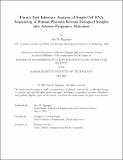Pareto Task Inference Analysis of Single-Cell RNASequencing of Human Placenta Reveals Biological Insightsinto Adverse Pregnancy Outcomes
Author(s)
Eppinger, Aria R.
DownloadThesis PDF (6.575Mb)
Advisor
Lauffenburger, Douglas A.
Terms of use
Metadata
Show full item recordAbstract
Adverse pregnancy outcomes (APOs), such as preeclampsia, fetal growth restriction, and preterm birth, occur in 10-15% of pregnancies. There is limited knowledge of how the cellular states in the placenta and decidua tissues are altered in women with particular APOs or may contribute to APOs. Single-cell RNA sequencing (scRNAseq) approaches have characterized cellular populations and interactions at the maternal-fetal interface using traditional dimensionality-reducing methods such as UMAP-based clustering. However, these techniques may generate limited representations of nuanced cellular functions and biological relationships among and within cell clusters. Pareto Task Inference (ParTI), a dimensionality reduction technique that fits data to an n-dimensional polygon or polytope, models how cells optimize among multiple biological functions and transition between states. We applied ParTI to assess its ability to identify nuanced cellular states and intercellular relationships and to highlight biological mechanisms underlying specific APOs. We analyzed scRNAseq data from 50 whole placental homogenates collected from healthy pregnancies and those complicated by fetal growth restriction (FGR), preterm preeclampsia (PrePET), spontaneous preterm birth (PTB), term preeclampsia or gestational hypertension (TermPET/GHTN), or type 1 diabetes (DM1). ParTI was applied to the dataset with 1) all main cell lineages (B-cells, trophoblasts, stromal, endothelial, Haufbauer, T-NK, maternal myeloid cells) and 2) syncytiotrophoblasts (SCTs), a sublineage of trophoblasts. Marker genes and gene set enrichment analysis for the ParTI polytope vertices, called archetypes, were performed to assess the biological states associated with the archetypes. We demonstrated that the ParTI polytope can separate both broad cell lineages and sublineages, suggesting that iteratively applying ParTI can serve as an alternative clustering approach when cell-lineage marker genes are previously known. Additionally, ParTI applied to SCTs separated healthy controls from pregnancies complicated by specific APOs. Gene set enrichment analysis of the cells proximal to the archetypes suggests biological differences in SCTs with specific APOs compared to the controls. Thus, ParTI can identify biological mechanisms underlying specific APOs and be applied to additional datasets to uncover biological relationships among and within cell-type clusters.
Date issued
2025-05Department
Massachusetts Institute of Technology. Department of Electrical Engineering and Computer SciencePublisher
Massachusetts Institute of Technology